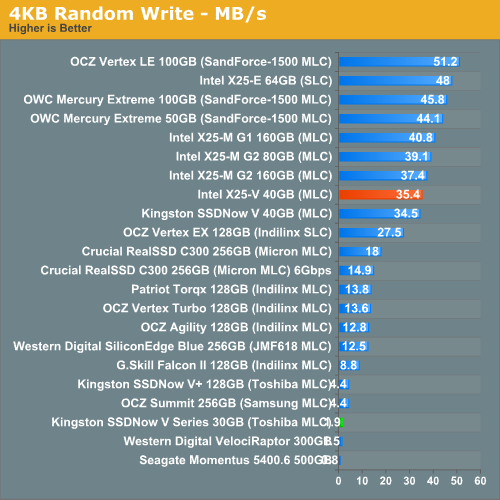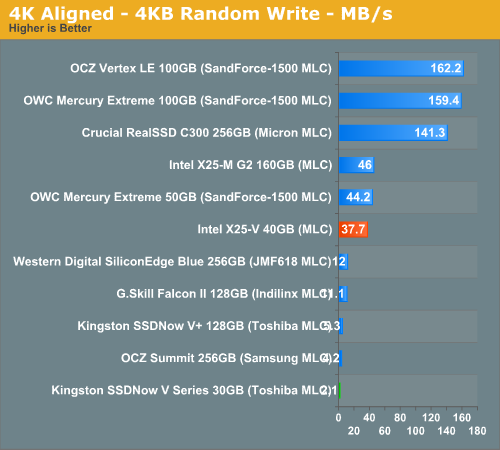Intel's X25-V & Kingston's 30GB SSDNow V Series: Battle of the $125 SSDs
by Anand Lal Shimpi on March 19, 2010 12:00 AM EST- Posted in
- Storage
Random Read/Write Speed
This test reads/writes 4KB in a completely random pattern over an 8GB space of the drive to simulate the sort of random access that you'd see on an OS drive (even this is more stressful than a normal desktop user would see). I perform three concurrent IOs and run the test for 3 minutes. The results reported are in average MB/s over the entire time.
I've had to run this test two different ways thanks to the way the newer controllers handle write alignment. Without a manually aligned partition, Windows XP executes writes on sector aligned boundaries while most modern OSes write with 4K alignment. Some controllers take this into account when mapping LBAs to page addresses, which generates additional overhead but makes for relatively similar performance regardless of OS/partition alignment. Other controllers skip the management overhead and just perform worse under Windows XP without partition alignment as file system writes are not automatically aligned with the SSD's internal pages.
First up is my traditional 4KB random write test, each write here is aligned to 512-byte sectors, similar to how Windows XP might write data to a drive:

Intel's drives have traditionally done very well in random write tests and the X25-V is no different. Here it performs like a much more expensive X25-M G2. The SSDNow V Series Boot Drive however is at the bottom of the charts in single digits here.
Running 4K aligned writes (similar to Windows 7 or OS X 10.5/6) doesn't improve the situation much in either case:

Random read performance is equally strong for Intel:

And equally weak for Kingston.










78 Comments
View All Comments
samspqr - Monday, March 22, 2010 - link
I agree with your posts on the other thread: I don't care about IOPS, just like getting more points in a benchmark won't make me happy by itselfI'm totally in the dark with respect to SSDs so far; with things as they are now, I guess I'll have to wait till I get my hands on one of them and can do my own testing (general feeling, then 3D rendering, video editing and encoding)
Taft12 - Saturday, March 20, 2010 - link
Rendering performance is not really an important bechnchmark for a general desktop computing website such as this.samspqr - Monday, March 22, 2010 - link
well, if it is in the CPU reviews, then it could be here too, coudn't it? at least if they found out that there's some difference, which is why I'm askingsamspqr - Friday, March 19, 2010 - link
here it is:http://www.3dprofessor.org/Reviews%20Folder%20Page...">http://www.3dprofessor.org/Reviews%20Folder%20Page...
they halved the rendering times by moving from a Western Digital 1TB RE-2 to a velociraptor, on a dual QX9775 board
soltari - Friday, March 19, 2010 - link
The kingston (intel) 40gb bootdrive was an awesome drive while it lasted. Mine actually did arrive last december with trim firmware on it, to my pleasant surprise. However after it died after purring along for 10 days and faced with no replacement possibility due to intel now wanting to sell only their identical more expensive drives i had to get a new one and for sure wasnt going to pay 35 dollars more to get the same drive back. An OCZ vertex 60gb is doing the purring now without issues.still the small SSD drive to run your O.S. from is an amazing improvement to overall performance. For this these new small cheap drives are great.
davepermen - Friday, March 19, 2010 - link
I use the X25-V in a Media Center setup (all actual data over the (gb) network). the -V delivers absolutely stunning performance, resulting in a fast to boot, very snappy system. and it has enough spare space for recording tv before it gets shifted to the winhome server.i could never get the kingston solution when seeing it's random performances. it's imho the main thing that makes an ssd feel fast. the media center is always "there", always "reacting". and even while the 40MB/s write speed is slow, the fact that it delivers nearly constant 40MB/s no matter if it's sequencial or random does it still perform quite fast (faster than hdds) in most real life cases (like installing the os).
i'm happy to get 10GB more space for the same price (a big thing in such low-storage devices), and i'm happy to get the overall more snappy and responsive performance.
for me, it's Intel: 1, Kingston: 0.
Shadowmaster625 - Wednesday, March 24, 2010 - link
Just like anand, here is another example of mindless intel worship.1. They arent the same price. One is 30% cheaper.
2. For media center applications, either would work perfectly fine, so obviously you dont know what you're talking about.
dagamer34 - Friday, March 19, 2010 - link
So definite improvement when using an SSD in media center? I've been meaning to get one, but didn't think that my primary apps could fit in 40GB. Seems a bit small.buzznut - Monday, March 22, 2010 - link
It depends on your install. You can easily get a win7 installation down to 10 gigs by turning things off like system restore, page file, and hibernation.I use the 40GB Intel drive and have Win7 pro, Office, flash, and any number of small productivity apps plus Heroes V with all the expansions. 15GB free atm, plenty of room to add PowerDVD and whatnot.
kmmatney - Friday, March 19, 2010 - link
" You gain better sequential performance and concurrent IOPS, but you have no way to actively curb performance degradation. "Can you schedule the SSD Toolbox to perform a manual TRIM. WOuldn't be so bad then - set it to run once a week and forget about it.
I have to say, Intel wins this round, easily. The Kingston would have had to perform much better to make up for the smaller drive size. I would expect that the Kingston will have to come down in price to remain competitive.